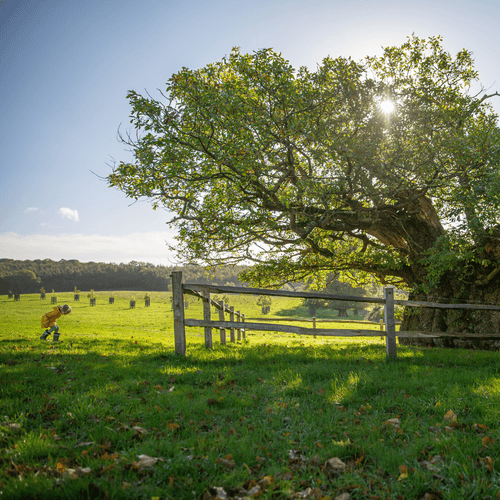Why do we love trees so much?
Posted by Zuza Featherstone on 28th Nov 2022
Our South Downs National Park Ambassadors are always outside advenutting. Zuza is an Ecologist and has a passion for trees, she has written a fantastically detailed post about why people love trees so much.
You can follow Zuza HERE

People were always fascinated by trees and woodlands. We are naturally drawn to woody areas, groves and forests. There is a tendency to seek and find solace in being present among trees and in woodland settings. It is well documented that a walk among the trees reduces the anxiety and the forest bathing is increasing in its popularity, shinrin yoku has been practiced in Japan for centuries.
Very few people don’t admire and enjoy a view of an old tree. We appreciate the aesthetics and character, often wondering what that tree has witnessed in its lifetime.
However, the connection between human and trees is deeply rooted in our cultures, mythology, literature and folklore. Throughout the centuries, people believed that trees had magical powers, powers to heal and protect from natural disasters and provide protection.
Across Europe oak was always associated with lightning. It represented gods associated with lightning, like Zeus, Thor, Perun to name the few. Often oaks are national symbols and are named trees. They are often associated with longevity, strength, power and justice. In Slavic mythology branches represented heaven, the trunk the world of mortals and the roots represented the underworld. In Celtic mythology oak was considered to be a sacred tree.

In eastern Europe, the name of the month of July, for example lipiec (Polish) and lypeń (Ukrainian) refers to flowering limes. The Lime tree is described as sacred in Slavic paganism and symbolises fertility and in some cultures women often asked for good luck. On the other hand, in Germanic folklore lime trees were connected to restoration of peace and justice.
Yew is another tree which is considered sacred. It was worshiped by Druids and is associated with their longevity and regeneration. Drooping branches can produce roots, forming new trees to grow. Yews are often found in old churchyards and in groves.
Willow in Asian folklore often was associated with grief and loss, however across many cultures is considered a symbol of fertility and rebirth. Willow was considered to bring good luck and the wind blowing through the delicate branches was believed to be a whisper of elves. In some Slavic folklore willows were considered a gateway to the underworld or hiding placed to fairies and other mystical creatures.
There are many more cultural tree-associated symbolisms across the world, for example the olive branch. Ash was believed to hold healing properties, hawthorn was a sacred tree in many cultures across Europe.
Apart from being an object of worship, trees were a provider of food, products for construction of buildings, fire wood, as well as over the centuries important tools were made out of wood. What we see today is a result of some forms of human intervention in the past, which provide us with old trees full of character. Management still continues till today. Normally, it is to prolong the life of old trees or minimise the collapse and prevent structural damage to the tree. If a tree partially collapses more often than not some work is undertaken to balance the tree.
Traditional management techniques
Oaks, hornbeams, ash, willows, and beeches were pollarded over the centuries. That means that they have been cut at about 2-3m height to prevent livestock grazing on new growth. Branches were repeatedly cut to the same point to provide fodder (food for animals), timber for building and other uses. In the UK about 150 years ago pollarding stopped due to socio-economical changes and slowly the knowledge passed through generations of the technique has disappeared. In the last few decades a revival of the desire to learn about management and ecological importance of ancient pollards sparked an increase in research attempts to gain as much data and understanding about origins of this technique. However, for children the best known pollard is the Family Tree, where Stickman and his family lives.

Today, those ancient trees are given a helping hand to survive by not allowing younger vegetation to overshadow them. It is called “halo releasing”, when younger and more vigorous trees take out the space. During this process “pollard of the future” are created allowing the continuity of the habitat, providing our children and grandchildren with experiencing, seeing and admiring the same gorgeous and iconic trees as well as creating the new ones, which will take centuries to grow.
Coppice was an old woodland management technique, where a tree was cut at the ground and allowed to regrow. The most popular are hazel and sweet chestnut coppices. This technique in recent years started to gained popularity and products from coppicing are often are desired by gardeners. Bean poles, pea sticks, hazel hurdles provide local and rather desirable addition for veg plots and allotments. Sweet chestnuts provide superb fence posts, which can be found throughout our countryside. Apart from products coppicing helps to create habitat for many endangered species, such as Pearl-bordered Fritillary butterfly. Creating clearances within coppice copse let light penetrate to the ground allowing small flowers to grow. Common violets are a food plant for many endangered butterflies, brambles producing flowers are a good nectar source for many insects, blackberries on the other hand are food for small mammals, such as the dormouse.

So next time you see some activity in your local park, woodland or on a common – ask the workers what are they doing, they might explain or point you towards people who are very happy to provide much more detail about their management. Countryside workers are always very happy to chat about their work. When you look at your wooden floor, at wooden beams in your home, at fence panels in your garden, or wooden furniture remember they are all a result on woodland management.

